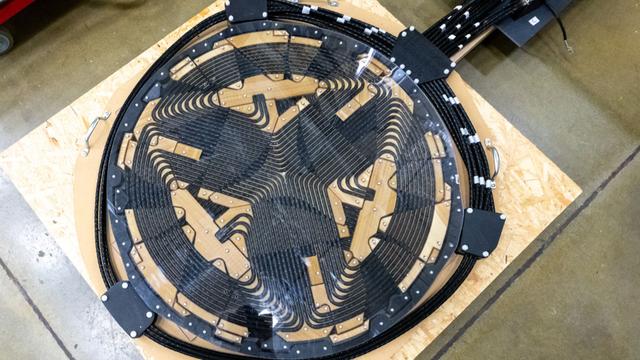World News02.08.2024
World record-breaking wireless EV charger delivers 270 kilowatts of power: US

QAZAQ GREEN. Researchers at Oak Ridge National Laboratory (ORNL) have successfully demonstrated the first 270-kW wireless electric vehicle (EV) charging technology, reports Interesting Engineering.
A team at the Department of Energy’s institution had earlier set a record for wireless EV charging with its demonstration of a 100 kW charger in March.
The demonstration was done in partnership with the Volkswagen Group with the the wireless power transfer of 270 kW being showcased on a Porsche Taycan EV.
“In the past three months, the ORNL vehicle power electronics and electric drives research teams have set impressive world records for wireless charging,” said Lee Slezak, DOE’s Vehicle Technologies Office technology manager for grid and charging infrastructures, in a statement.
Compact high-power system
The Porsche Taycan, as a light-duty passenger vehicle, faces challenges in accommodating conventional large and heavy wireless power transfer systems due to space, weight, and volume limitations.
According to the team, current research is focused on developing wireless charging systems for light-duty cars that can achieve up to 11 kW of power and 92 percent efficiency. Industry standards currently cover power levels up to 20 kW.
ORNL developed a lightweight system for powering the Porsche Taycan, utilizing polyphase electromagnetic coupling coils. These coils, slightly over 19 inches in diameter, deliver high power density in a compact form.
Drawing inspiration from the wireless charging of small gadgets, the system’s distinctive coil design and geometry enable the transmission of exceptionally high power levels.
Researchers say this is achieved through rotating magnetic fields created by the coil phase windings, which enhance power delivery. The charging system was efficiently incorporated into the vehicle’s undercarriage.
The team of researchers that carried out ORNL’s record-setting 270-kW wireless power transfer to a light-duty passenger vehicle.
Power density is crucial in wireless charging, showing how much power a system handles relative to its size. ORNL’s system achieves a 50 percent charge in 10 minutes at over 95 percent efficiency, with a 4.75-inch gap between coil and ground.
Wireless power transmission technology also includes protection mechanisms against short-circuiting, overheating, and exceeding voltage and current restrictions. When power outages or other unforeseen circumstances prevent safe power transfer, these systems can start shutdown operations.
“We’re also working with Volkswagen on developing a polyphase system for residential charging applications and collaborating on the development of a lightweight enclosure design that will improve mechanical, electrical, thermal, and magnetic performance,” said Omer Onar, ORNL’s leader of the Vehicle Power Electronics group and lead researcher on the Porsche demonstration.
Future of EV charging
For the past decade, ORNL researchers have advanced wireless charging technology. In 2016, they transferred 20 kilowatts to an SUV using their own inverter and coupling tech.
By 2018, they reached 120 kW in lab tests with conventional coils. The recent 100- and 270-kW tests are the first applications of ORNL’s polyphase system on electric vehicles.
ORNL hopes that by extending the range and simplifying the charging process, its pursuit of greater charge rates will promote the usage of EVs. This is especially important for light-duty passenger cars used for everyday commuting.
“This achievement gets us one step further to the reality of a future where an electric vehicle can pull into a charging station and recharge in the same time it would take to walk into a store and grab a snack,” said Burak Ozpineci, ORNL’s corporate fellow and distinguished researcher who leads vehicle and mobility systems research.
In the near future, ORNL and Volkswagen intend to continue collaborating to enhance the 270-kW charging prototype by making it a more affordable and scalable system.
These trials help DOE achieve its extreme fast-charging objective, which is to create a system that can charge electric vehicles in 15 minutes or fewer while supplying 250–300 kilowatts of power.
Kazakhstan and UAE reaffirm strategic energy partnership with 1 GW wind project
Solar becomes EU’s top power source for the first time ever
How decentralised renewables transform healthcare services in rural Zimbabwe
Chinese company to build solar and wind power plants in Kyrgyzstan
Seaturns raises €2.45 million to industrialize wave energy technology and accelerate global rollout
Trump signs executive order to end subsidies for wind and solar energy
Uzbekistan's solar and wind power plants generate 5 Billion kWh since beginning of the year
Green Corridor Alliance JV registered in Baku to promote green energy development in Central Asia and the South Caucasus
In the EU renewable energy supply grew by 3.4% in 2024
IRENA accepting renewable energy project proposals in Central Asia until August 15
Astana to host Electronica Expo Kazakhstan Electronics Exhibition
WB gives rundown of Azerbaijan's green energy grid volume prospects
US solar sets new records as renewables nearly match natural gas – EIA
‘Wings’ on poles: Bill Gates-backed breakthrough wind turbine facility breaks ground
Perovskite tandem solar cell achieves new efficiency record
Kazakhstan and China endorse draft SCO joint statement on sustainable energy development
Innovative research on organic solar cells for space applications
Kazakhstan and Uzbekistan drive green energy progress in Central Asia
KazMunayGas launches pilot green hydrogen project in Atyrau
How private homeowners in Kazakhstan can make money from solar panels











